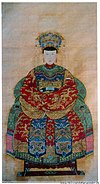| Xiapei | |||||||
|---|---|---|---|---|---|---|---|
 Portrait of Empress Dowager Du wearing scarf-like xiapei over her shoulders; a peizhui (ornament) is hanging at the front end, Song dynasty. | |||||||
 Portrait of Mrs Chen wearing the waistcoat-like xiapei, Qing dynasty | |||||||
| Chinese name | |||||||
| Chinese | 霞帔 | ||||||
| Literal meaning | "Rosy cloud scarf" or "Rosy cloud cape" | ||||||
| |||||||
| Alternative Chinese name | |||||||
| Chinese | 霞帔坠 | ||||||
| Literal meaning | Rosy cloud scarf pendant | ||||||
| |||||||
| Korean name | |||||||
| Hangul | 하피 | ||||||
| Hanja | 霞帔 | ||||||
| Literal meaning | Rosy cloud cape | ||||||
| |||||||
Xiapei (Chinese: 霞帔; lit. 'Rosy cloud scarf'), also known as hapi (Korean: 하피; Hanja: 霞帔) in Korea,[1] is a type of Chinese clothing accessory in either the form of a long scarf, a neckband, or in the shape of waistcoat depending on the time period.[2][3] It was also referred as xiapeizhui (Chinese: 霞帔坠) when it was ornamented with a peizhui (Chinese: 帔坠; pinyin: pèizhuì; lit. 'pendant') at its front end; the peizhui ornament could be made of diverse materials, such as silver, jade, and gold.[4]
The xiapei appeared as early as the Qin dynasty and continues to be worn until now (although the shape of the xiapei evolved with time).[2] Since the Song dynasty, peizhui started to be used to ornate the xiapei.[5] In the Ming and Qing dynasties, the xiapei, along with the fengguan, became the daily clothing of queens and the formal clothing of the wives of senior officials.[2] The xiapei eventually became part of the traditional Chinese wedding attire for commoners.[2] The xiapei was also introduced and worn in the late Goryeo and Joseon where it was called hapi; it was bestowed by the Ming dynasty along with the jeokui and many other garment items.[1][6]
- ^ a b "Hapi(霞帔)". Encyclopedia of Korean Folk Culture.
- ^ a b c d Yang, Shaorong (2004). Traditional Chinese clothing : costumes, adornments & culture (1st ed.). San Francisco: Long River Press. pp. 32–33. ISBN 1-59265-019-8. OCLC 52775158.
- ^ Lewandowski, Elizabeth J. (2011). The complete costume dictionary. Lanham, Maryland: The Scarecrow Press. p. 319. ISBN 978-0-8108-4004-1. OCLC 694238143.
- ^ KESSLER, ADAM T. (2017-08-23). "The Last Days of the Song Dynasty: Evidence of the Flight of Song Officials to Southeast Asia before the Mongol Invasions". Journal of the Royal Asiatic Society. 28 (2): 315–337. doi:10.1017/s1356186317000384. ISSN 1356-1863. S2CID 164576372.
- ^ "History of Peizhui - Most Exquisite Hanfu Ornament". www.newhanfu.com. 28 December 2020. Retrieved 2022-01-02.
- ^ "Jeogui: The Most Formal Ceremonial Robe of the Joseon Queens". National Museum of Korea.